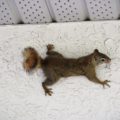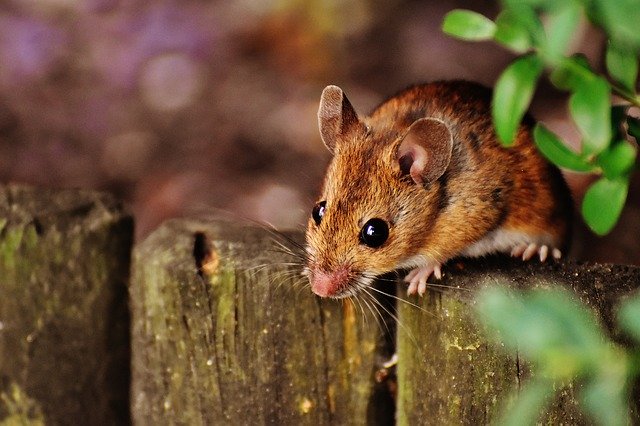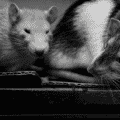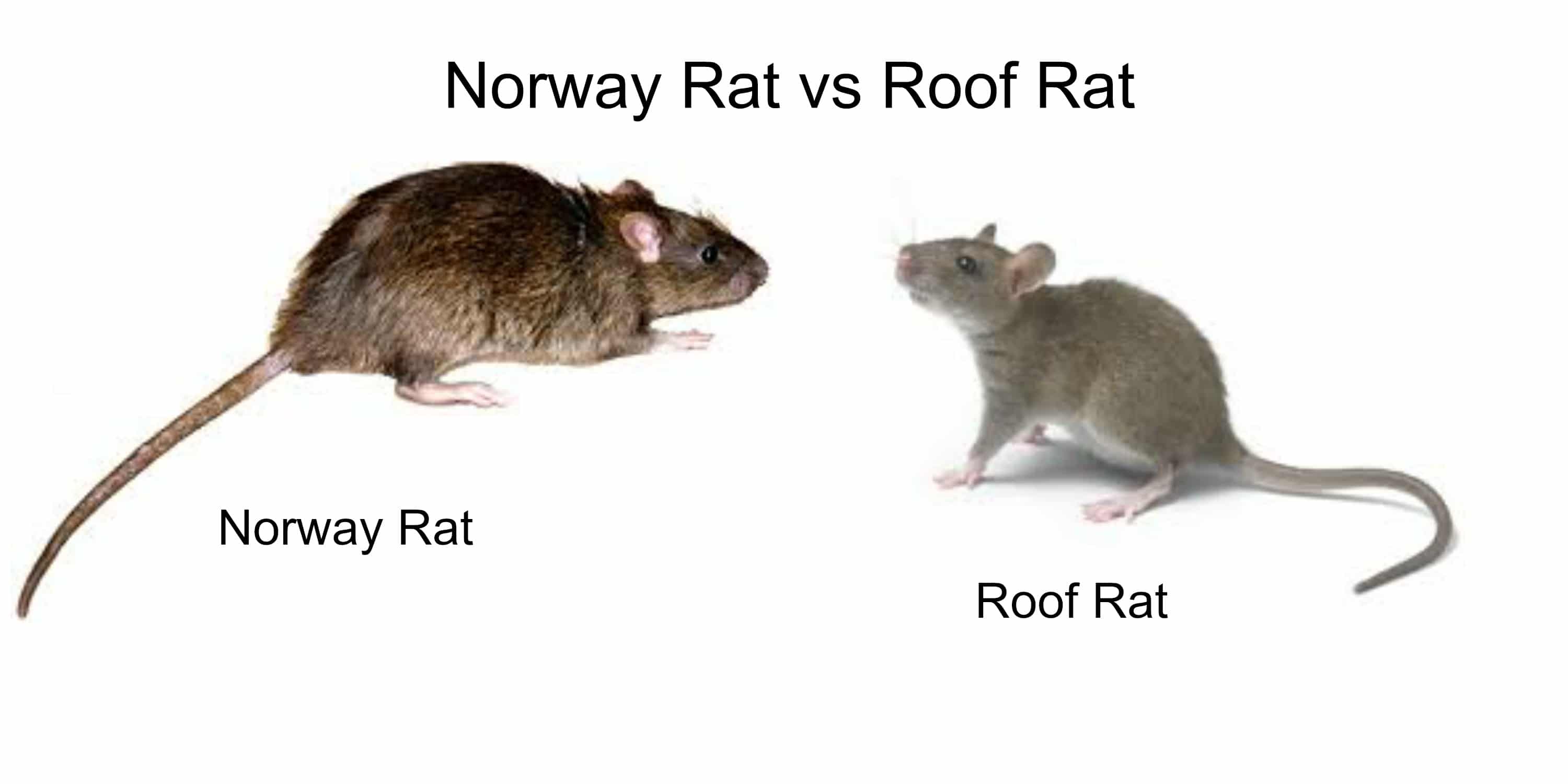Table of Contents
Scrabbling on the roof and scurrying in the attic – is it rats, or is it squirrels? When you have pests to rid yourself of, the species may not seem as urgent as just finding a solution. But a guessing game of rat vs. squirrel could keep you from discovering entry points and steer you towards the wrong solution.
Rats and squirrels are very different creatures, and the differences don’t end with the bushiness (or lack of bushiness) on a tail, or whether their face is cheeky or pointy. Rats and squirrels have different habits, preferences, and lifestyles. Being able to tell one from the other can make it easier to get them out of your hair.
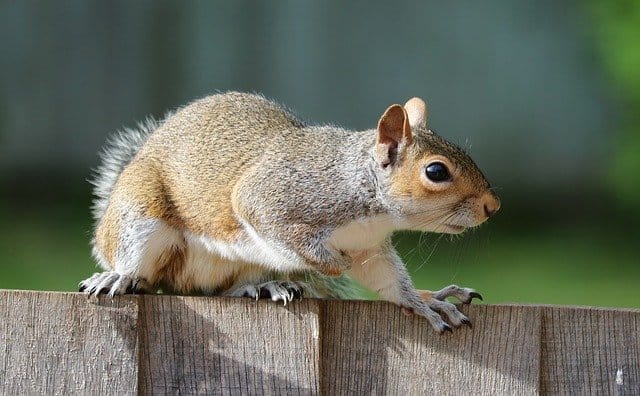
Oh, Rats!
When it comes to the rat family, two main types originated millennia ago – one in India (the black rat), and one in China (the brown rat). Arguably, rats have more successfully conquered the world than any other species, spreading by land and sea. Keen swimmers, rats traveled from island to island taking hold in every corner of the globe except for the North and South Poles.
It is worth mentioning that a third type of rat, the Woodrat, is common in some parts of the US but it is rarely a problem for homeowners.
Rattus rattus
The black rat is a medium sized rat that has a length of 6-8 inches and typically weighs about half a pound. The black rat carries a variety of different monikers, some in reference to geography, some in reference to habitat, and some to color variants:
- Palm rat
- Old English rat
- Roof rat
- Gray rat
- Blue rat
Black rats are often arboreal, meaning they climb trees with ease and skill; in the rural areas, they scamper up and down trees and build their nests above ground. In urban areas, they seek the heights as well, preferring to gain access into homes from the roof and hole up in attics, inside walls, or upper floor ceilings.
In houses, black rats will ardently chew through insulation and even wires, dragging off chunks left by their destruction to create large messy nests. The females become fertile at about 90 days, give or take a month, and are capable of churning out a litter of half a dozen pups every new moon. A pair of breeders can quickly cause a property to be overrun.
Rattus Norvegicus
The brown rat is larger and more aggressive than black rats and has generally displaced them in regions where their territories overlapped. These rats are incredible swimmers and can carry food or young through the water from place to place.
The brown rat has had many names through the centuries, including:
Norway rat
Hanover rat
Parisian rat
Common rat
Street rat
Sewer rat
Water rat
Wharf rat
Brown rats prefer to be underground, and create large families in subways, building basements, and crawl spaces along the waterside or in tenements. In houses, brown rats can cause incredible destruction, even going so far as to tunnel under foundations and chew through garbage cans to find food. They are big enough to pose a serious threat to cats and small dogs.
These large rats are primarily nocturnal, and as populations grow, a strict caste system appears. Subordinate rats housed furthest from water and food and forced to wait their turn while dominant rats feed. They reach sexual maturity at three months, but while females begin breeding instantly, males must fight their way up through the ranks to defeat others and win the right to mate. Females have half a dozen or more litters a year, and as many as 22 pups per litter have been reported.
For more information about these two species please see Norway vs Roof Rats.
Getting Squirrely?
Squirrels are less feared than rats because of their bushy fur and comedic antics, but they can cause just as much destruction as rats if they decide to horn in on your territory. The main squirrels that invade human homes are “tree squirrels.”
Sciurus niger
The fox squirrel is the biggest American squirrel stretching up to two feet from nose to base of the tail; they typically have an enormous brush that can add another foot to their length. Fox squirrels can weigh up to 2 pounds or more, and make a formidable opponent when cornered. Initially restricted to the eastern U.S., they have made their way to the west coast.
The fox squirrel is strictly a daytime animal, and will eagerly take advantage of attic space if a handy hollow tree trunk is hard to find. They will build a nest in the winter that is made of many layers and materials woven together for a sturdy habitat. The females reach maturity at just under a year of age and produce two litters each year of (generally) 3 kits each.
Fox squirrels are determined once they have decided to enter a home. They will exploit any small crack to get in, chewing their way through wood, insulation, and walls. They can be heard running back and forth and up and down during the day – which is a good sign you have squirrels vs. rats.
Sciurus carolinensis
The eastern gray squirrel inhabits more than half of the United States, from the eastern seaboard to the edges of the breadbasket states. At 10 to 12 inches long and sporting a fluffy tail three quarters that length, males and large females can weigh in the neighborhood of a pound. They are more likely to live close to humans than their larger cousin, the western gray squirrel, that lives almost exclusively in California.
Gray squirrels are not nocturnal like rats. They are extremely lively around dawn and dusk, resting briefly in the heat of the day. They don’t reproduce quite as quickly as rats, either, with the typical female breeding and nesting only twice a year. The litter is usually 2-6 kits, and the mother may move them from location to location to stay clear of insects and maintain a clean habitat.
Grey squirrels are intensely destructive, gaining entry to homes through chimneys or vents, tunneling through insulation, or clawing into food containers. They can wreak havoc on any electrical systems, including phone, cable, and HVAC lines.
Tamiasciurus hudsonicus
The American red squirrel, immortalized by John James Audubon as the “Hudson’s Bay Squirrel,” is a smaller squirrel living in the northern U.S. where conifer trees are plentiful. This petite red squirrel is only a little over a foot long including the tail when mature, and weighs a scant half pound.
In a startling turnaround, instead of only males mating with multiple partners, the female red squirrel will mate with a dozen or more males before retiring to gestate and bear her single litter of around five kits per year. Some years the female will skip breeding, and breed twice the subsequent year.
American reds are fiercely territorial, but indolent when it comes to housing. They take advantage of any entry into a home to nest in attics or inside vents in HVAC systems, causing severe issues due to vent congestion, blocked air pathways, and feces dust spewed into breathing air. These squirrels are exceedingly frisky and can be heard barrelling through walls and across ceilings at a furious rate.
Rat vs. Squirrel: Signs to Watch For
The main differences between rats and squirrels aren’t size, as different squirrel species can match different rat species by length and weight. When it comes to figuring out which animal is scampering around your home, the signs to look for include:
Area of the home infested
If the problem is in your basement, it’s far more likely to be rats than squirrels, specifically brown rats. However, if the problem is overhead, it could be either the climbing black rat or any species of squirrel, (not to mention, other pests).
Time of day you hear disturbances
If the noise is mostly at night, rats are likely to blame. Rats are overwhelmingly nocturnal, and only come out when they feel darkness can provide them with cover. Squirrels, on the other hand, are diurnal so they could be the ones responsible for the racket you hear during the day.
Appearance of droppings
Rat droppings vary slightly between the two species of rat; the brown rat evacuates droppings about three-fourths of an inch long, straight, with rounded ends. The black rat, however, will leave droppings about half of an inch long, curved like a sausage, with pointed ends. Rat feces are generally dark brown to black.
Squirrel droppings are smaller and smoother, similar in size and shape to a grain of rice with a straight body that is slightly thicker in the middle and rounded ends. Squirrel feces will typically be lighter in color than rat leavings, with a light brown or reddish-brown color.
Wrapping It Up!
Rats and squirrels can be a danger to your home due to their propensity for chewing electrical wiring. Getting rid of them as soon as you realize you have a problem – or being proactive to avoid them in the first place – can help keep you, your home, and your family safe. Natural solutions to get rid of a rat or squirrel colony can be useful, as can repellents. Preventive measures (like sealing up possible entries) to prevent any future issues with rats/squirrels can go a long way to keeping your home rodent-free.

